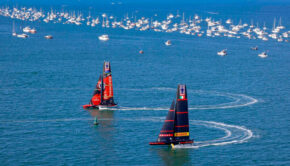America’s Cup: Next generation to be fully foiling catamaran
Published on April 13th, 2014
Despite being a multihull guy, American Gino Morrelli is among the most seasoned designers currently involved in the America’s Cup.
Gino’s involvement dates back to the 1988 Deed of Gift Match, where he helped Dennis Conner’s Stars and Stripes team create the winning catamaran. When the America’s Cup returned to multihulls again for the 2010 Deed of Gift Match, Morrelli was back too, working with challenger BMW Oracle Racing to refine their 90-foot trimaran.
After assisting in writing the AC72 rule for the 34th America’s Cup, and then working with the New Zealand challenger in that event, his firm Morrelli & Melvin are back again to help create the design rule for the 35th Match.
Gino’s partner Pete Melvin had reported in February that the new boat would smaller, but not noticeably slower. Their tests indicated the new class could be similar in speeds downwind as the AC72, but a bit slower upwind. Gino thinks the new boat could prove faster on all points of sail.
Gino hosted a seminar at the Strictly Sail Pacific show on Friday, providing some additional insight into the next boat for the America’s Cup. Here are some bullet points from his presentation:
– The design rule is completed. The boats are designed to sail in a range of 6 to 30 knots, but the final rig size will be determined when the venue is selected.
– Reducing the size of the boat from 72-feet to 62-feet will reduce the loads by half, which will reduce structural costs.
– The smaller size boat will require less sailing crew (from 11 to 8) and less support crew, thus reducing the budget needed.
– Wing dimensions will be tightly specified, which will reduce design costs.
– Hull shape will have more bow volume to improve safety.
– Boats will foil on all points of sail.
– Daggerboard adjustment will be simplified slightly to reduce costs, and rudder angle will be adjustable to improve foiling control.
Here are some of Gino’s estimations going forward:
– The design and build time is approximately 14-18 months.
– The AC72 rule was designed for the boats to be transportable. The new rule is not, so he expects the boats to be glued together. Given the time frame, this could require their assembly at the venue.
– While a flat sea state is preferred, Gino estimates the boats can handle a 6 to 7 foot swell as long as the peaks are far apart.
Here is Gino’s prediction on what could be the big difference with the new design:
Gino expects the teams to remain fully foiled through the upwind tacks. The team that can stretch the tack furthest, and keep the hulls up and out of the water the longest while heading straight into the wind before bearing away onto the new tack, could make significant gains. This technique should encourage tacking, and thus the races in AC35 could prove to be both high speed and highly tactical upwind.









 We’ll keep your information safe.
We’ll keep your information safe.